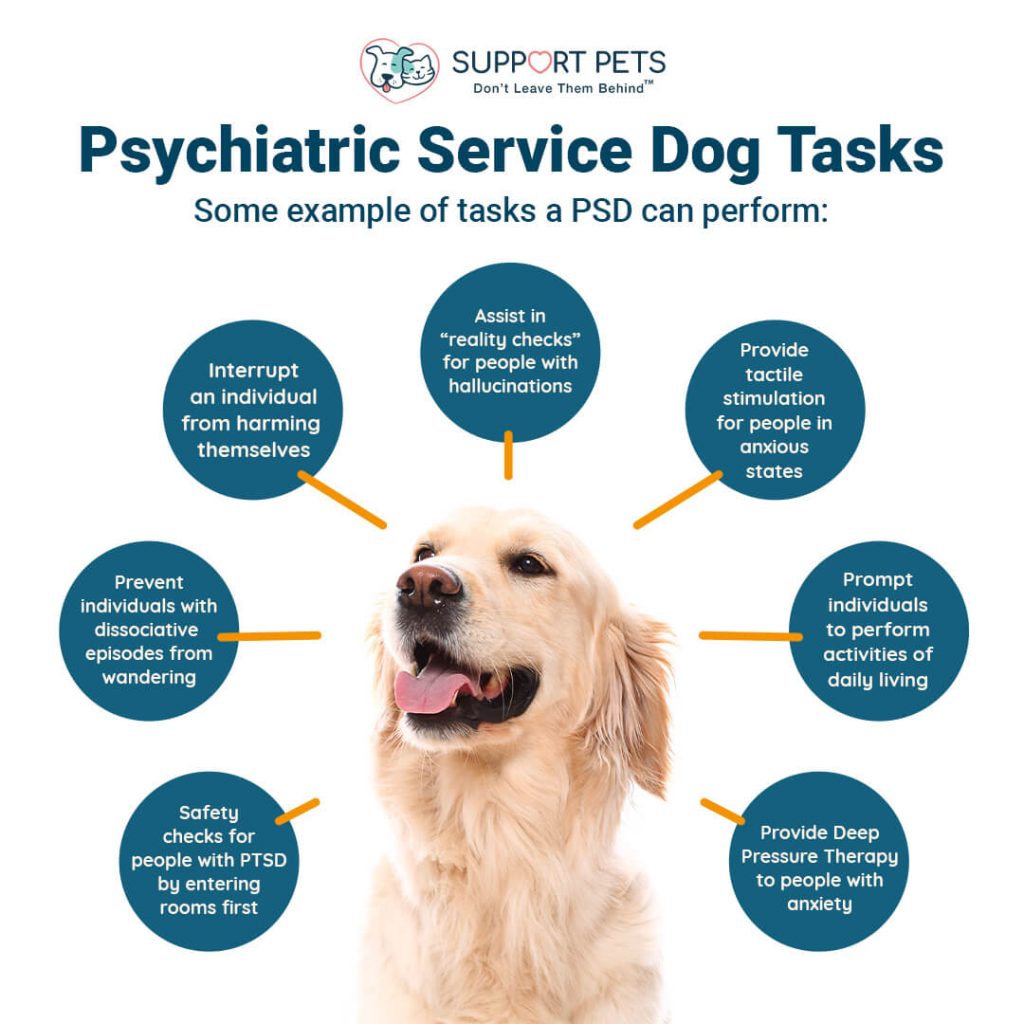Ever wondered how a Psychiatric Service Dog (PSD) can change someone’s life? These trained dogs do more than offer companionship. They provide vital support to people with mental illnesses. From helping during panic attacks to assisting with daily tasks, PSDs are crucial.

What is a Psychiatric Service Dog?
A Psychiatric Service Dog (PSD) helps people with anxiety, depression, and other mental health issues. These dogs are trained to help with daily life challenges related to mental illnesses. Unlike support animals, PSDs get special training as defined by the Americans with Disabilities Act (ADA).
If you want to train your dog to become a PSD, learn more about our comprehensive PSD training program.
Service Dogs vs. Psychiatric Service Dogs (PSDs) vs. Emotional Support Animals (ESAs)
Training:
Service Dogs: Trained to help with physical disabilities.
PSDs: Trained to help with mental health issues by doing specific tasks.
ESAs: No special training is needed.
Public Access:
Service Dogs & PSDs: Through Federal regulations, these service dogs are granted access to ALL public spaces, no questions asked
ESAs: An ESA is protected by the Fair Housing Act and is allowed to live with its owner without repercussion.
Tasks:
Service Dogs: Perform tasks like guiding, alerting, or pulling wheelchairs.
PSDs: Perform tasks like calming panic attacks, helping with social interaction, and aiding daily routines.
Who Can Qualify for a Psychiatric Service Dog?
To qualify for a psychiatric service dog, a licensed health or medical professional must evaluate an individual and determine that the individual faces mental health issues that impact their daily life. These dogs are essential for those whose disabilities make everyday activities hard.
Common Mental Health Conditions:
Anxiety Disorders: Severe anxiety that makes it hard to function can be helped with a PSD.
Post-Traumatic Stress Disorder (PTSD): PSDs help people with PTSD by giving tactile stimulation during panic attacks and helping manage flashbacks.
Depression: PSDs offer companionship and help with daily routines for those with severe depression.
Bipolar Disorder: PSDs help stabilize moods and support during depressive or manic episodes.
Obsessive-Compulsive Disorder (OCD): PSDs interrupt compulsive behaviors and provide comfort to reduce anxiety from OCD.
For more information on how PSDs can help with daily life, check out our PSD training program.
What Specific Tasks Do Psychiatric Service Dogs Perform?
Psychiatric service dogs perform specific tasks that make daily life easier and safer for their owners. By assisting in public spaces and social interactions, PSDs provide invaluable support to individuals required because of a disability. Their training enables them to perform various tasks, such as:
Interrupt Harmful Behavior: PSDs can intervene and stop harmful behavior, providing an essential safety measure to their owners.
Assist in Reality Checks: For people who experience hallucinations, PSDs can help or provide a consistent behavior that reassures their owners of the reality of the situation.
Provide Tactile Stimulation: During a panic attack, PSDs can provide tactile stimulation, such as nudging or leaning on their owner to help ground and quickly reduce their anxiety levels.
Prompt Daily Living Activities: PSDs can prompt their owners to perform activities of daily living, such as taking medication, eating, or completing household tasks.
Deep Pressure Therapy: These dogs can provide deep pressure therapy by applying gentle pressure to their owner’s body which can produce a calming effect, similar to a weighted blanket, helping to reduce feelings of anxiety and stress.
Prevent Wandering: For individuals with dissociative episodes, a PSD can prevent wandering by guiding them back to safety. This guidance is essential for ensuring the safety of individuals who might otherwise become disoriented or lost.
Safety Checks: PSDs perform safety checks for people with PTSD by entering rooms first, alleviating hypervigilance and anxiety. The dog’s presence and initial assessment of the space can provide a sense of security, allowing the owner to enter the room with reduced anxiety. This task helps create a safer and more comfortable environment for individuals with PTSD.
Learn more about how to train your dog to perform these specific tasks by checking out our PSD training course.
How to Get a Psychiatric Service Dog
Training a psychiatric service dog (PSD) is a detailed process that requires time, patience, and commitment. PSDs are specially trained to help people with mental health conditions like anxiety disorders, PTSD, and other mental illnesses. Here are the key steps in psychiatric service dog training:
1. Assessment: Before training starts, an assessment of the handler’s needs and abilities is done. This helps determine the specific tasks the dog will need to learn. The assessment evaluates the handler’s physical and mental health conditions, living situation, and lifestyle to ensure the dog can support their daily life effectively.
2. Selection of a Suitable Dog: Choosing the right dog is crucial. The dog should have a stable temperament, be well-behaved, and have a strong desire to please their handler. This can involve getting a puppy or adopting an adult dog from a reputable breeder or rescue organization. The selected dog will become a service dog PSD after rigorous training.
3. Basic Obedience Training: Before learning specialized tasks, PSDs must master basic commands like sit, stay, and come. This foundational training ensures the dog is well-behaved and responsive, setting the stage for more advanced psychiatric service dog training.
4. Task-Specific Training: Depending on the handler’s needs, dogs can be trained to perform specific tasks to help with mental health conditions. They can learn to interrupt self-harm behaviors, retrieve medications, provide deep pressure therapy to reduce anxiety, and give tactile stimulation during a panic attack. This training ensures the dog can perform these tasks reliably in various environments.
5. Public Access Training: PSDs must learn how to behave in public spaces to assist their handler without causing disruptions. This training ensures the dog can work calmly in various environments, including crowded or noisy places. They learn to avoid inappropriate behaviors like jumping on people or begging for food.
6. Ongoing Support and Training: Our Psychiatric Service Dog Training course, in partnership with the International Canine Training Institute (ICTI), provides comprehensive training for your dog. This program includes modules and step-by-step instructions to apply advanced animal behavior theories. Handlers receive individualized support from a trainer, which is useful for overcoming challenges or understanding training concepts.
For more details on training your PSD, check out our training course.
Rights and Laws for Psychiatric Service Dogs
Psychiatric service dogs (PSDs) have special rights under the Americans with Disabilities Act (ADA). This means they can go to most places where other pets are not allowed. These places include:
- Shops
- Restaurants
- Schools
- Hospitals
- Hotels
Public Access Rights: Because PSDs are service dogs, they are allowed in public spaces. People can only ask if the dog is required because of a disability and what tasks the dog is trained to perform. You do not need special documents to prove your dog is a service animal, but some airlines may ask for forms when traveling.
Housing Rights: The ADA also protects PSDs in certain housing situations. This includes public and private university housing, government-run housing, and emergency shelters. The Department of Transportation (DOT) and the Department of Housing and Urban Development (HUD) also have rules to protect service dogs in housing and air travel. However, if a dog is not housebroken or is out of control, businesses and government agencies can ask for the service animal to be removed.
Training Requirements: Service dogs, including psychiatric service dogs, do not need to be professionally trained. Anyone with a disability has the right to train their own service dog. However, service dogs in training are not always covered by the ADA and may not be allowed in some public places unless state and local laws say otherwise.
Recent Changes for Air Travel: In late 2020, the DOT changed the rules for air travel. Emotional support animals are no longer considered service animals. However, psychiatric service dogs must now be treated the same as other service animals. For more details, you can check the U.S. DOT page on service animals.
Understanding these rights can help you know where your psychiatric service dog (PSD) is allowed to go and what legal protections you have. This makes it easier to manage daily life with a PSD, especially in public spaces and housing situations.
PSDs help with mental illnesses, including anxiety disorders and PTSD, by performing specific tasks and providing tactile stimulation during panic attacks. They are trained to support social interactions and assist with various mental health conditions.
Ready to start your journey with a Psychiatric Service Dog? Discover how to train your dog and unlock amazing benefits. Click here to get started





